PORSCHE CAYNNE 2004 1.G Owners Manual
Manufacturer: PORSCHE, Model Year: 2004, Model line: CAYENNE, Model: PORSCHE CAYENNE 2004 1.GPages: 379, PDF Size: 13.91 MB
Page 211 of 379
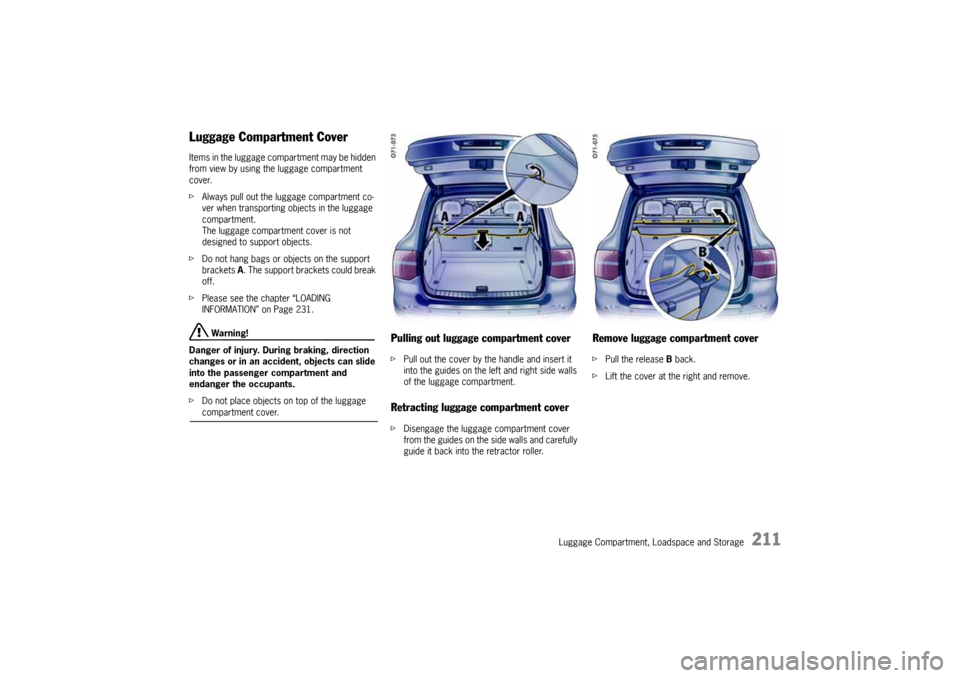
Luggage Compartment, Loadspace and Storage
211
Luggage Compartment CoverItems in the luggage compartment may be hidden
from view by using the luggage compartment
cover.
fAlways pull out the luggage compartment co-
ver when transporting objects in the luggage
compartment.
The luggage compartment cover is not
designed to support objects.
fDo not hang bags or objects on the support
brackets A. The support brackets could break
off.
fPlease see the chapter “LOADING
INFORMATION” on Page 231.
Warning!
Danger of injury. During braking, direction
changes or in an accident, objects can slide
into the passenger compartment and
endanger the occupants.
fDo not place objects on top of the luggage compartment cover.
Pulling out luggage compartment coverfPull out the cover by the handle and insert it
into the guides on the left and right side walls
of the luggage compartment.Retracting luggage compartment coverfDisengage the luggage compartment cover
from the guides on the side walls and carefully
guide it back into the retractor roller.
Remove luggage compartment coverfPull the release B back.
fLift the cover at the right and remove.
10_Cayenne_21_KW17.book Seite 211 Donnerstag, 9. April 2009 3:33 15
Page 212 of 379
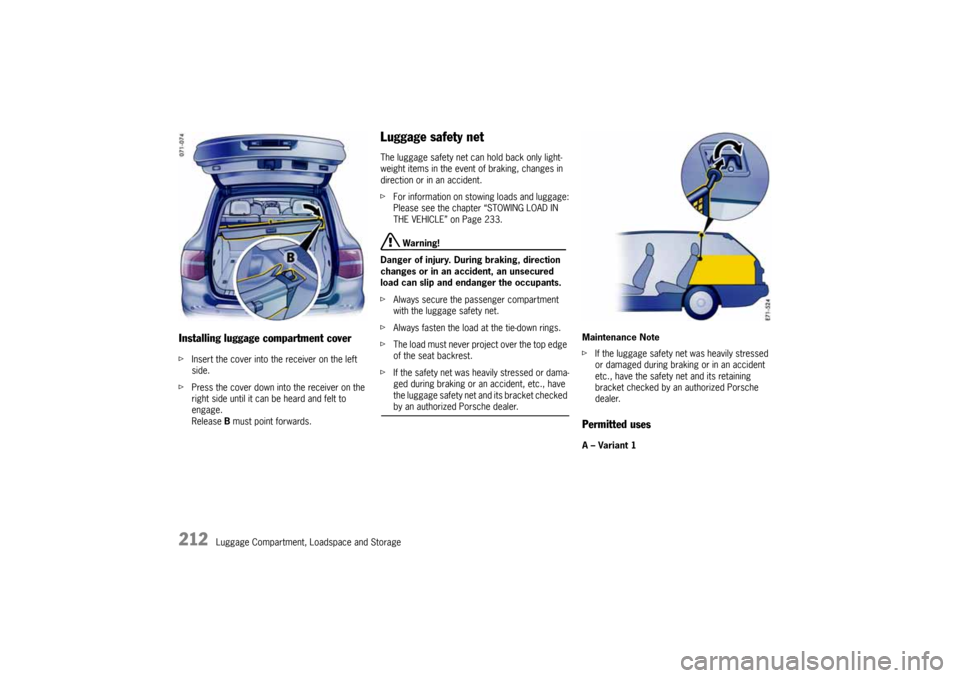
212
Luggage Compartment, Loadspace and Storage
Installing luggage compartment coverfInsert the cover into the receiver on the left
side.
fPress the cover down into the receiver on the
right side until it can be heard and felt to
engage.
Release B must point forwards.
Luggage safety netThe luggage safety net can hold back only light-
weight items in the event of braking, changes in
direction or in an accident.
fFor information on stowing loads and luggage:
Please see the chapter “STOWING LOAD IN
THE VEHICLE” on Page 233.
Warning!
Danger of injury. During braking, direction
changes or in an accident, an unsecured
load can slip and endanger the occupants.
fAlways secure the passenger compartment
with the luggage safety net.
fAlways fasten the load at the tie-down rings.
fThe load must never project over the top edge
of the seat backrest.
fIf the safety net was heavily stressed or dama-
ged during braking or an accident, etc., have
the luggage safety net and its bracket checked by an authorized Porsche dealer.Maintenance Note
fIf the luggage safety net was heavily stressed
or damaged during braking or in an accident
etc., have the safety net and its retaining
bracket checked by an authorized Porsche
dealer.
Permitted usesA – Variant 1
10_Cayenne_21_KW17.book Seite 212 Donnerstag, 9. April 2009 3:33 15
Page 213 of 379
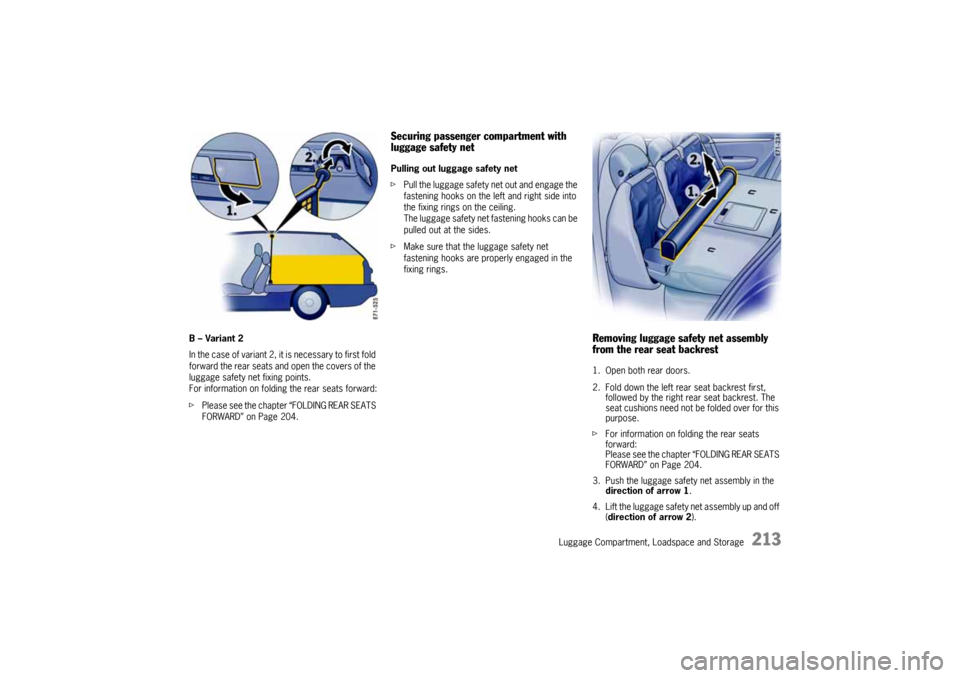
Luggage Compartment, Loadspace and Storage
213
B – Variant 2
I n t h e c a s e o f v a r i a n t 2 , i t i s n e c e s s a r y t o f i r s t f o l d
forward the rear seats and open the covers of the
luggage safety net fixing points.
For information on folding the rear seats forward:
fPlease see the chapter “FOLDING REAR SEATS
FORWARD” on Page 204.
Securing passenger compartment with
luggage safety netPulling out luggage safety net
fPull the luggage safety net out and engage the
fastening hooks on the left and right side into
the fixing rings on the ceiling.
The luggage safety net fastening hooks can be
pulled out at the sides.
fMake sure that the luggage safety net
fastening hooks are properly engaged in the
fixing rings.
Removing luggage safety net assembly
from the rear seat backrest1. Open both rear doors.
2. Fold down the left rear seat backrest first,
followed by the right rear seat backrest. The
seat cushions need not be folded over for this
purpose.
fFor information on folding the rear seats
forward:
Please see the chapter “FOLDING REAR SEATS
FORWARD” on Page 204.
3. Push the luggage safety net assembly in the
direction of arrow 1.
4. Lift the luggage safety net assembly up and off
(direction of arrow 2).
10_Cayenne_21_KW17.book Seite 213 Donnerstag, 9. April 2009 3:33 15
Page 214 of 379
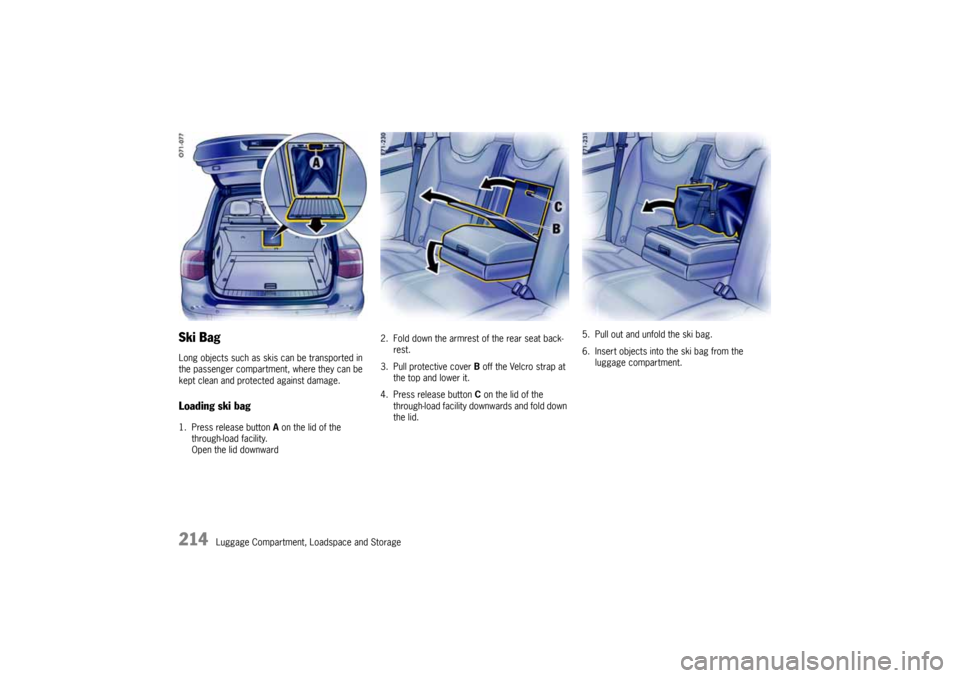
214
Luggage Compartment, Loadspace and Storage
Ski BagLong objects such as skis can be transported in
the passenger compartment, where they can be
kept clean and protected against damage.Loading ski bag1. Press release button A on the lid of the
through-load facility.
Open the lid downward2. Fold down the armrest of the rear seat back-
rest.
3. Pull protective cover B off the Velcro strap at
the top and lower it.
4. Press release button C on the lid of the
through-load facility downwards and fold down
the lid.5. Pull out and unfold the ski bag.
6. Insert objects into the ski bag from the
luggage compartment.10_Cayenne_21_KW17.book Seite 214 Donnerstag, 9. April 2009 3:33 15
Page 215 of 379
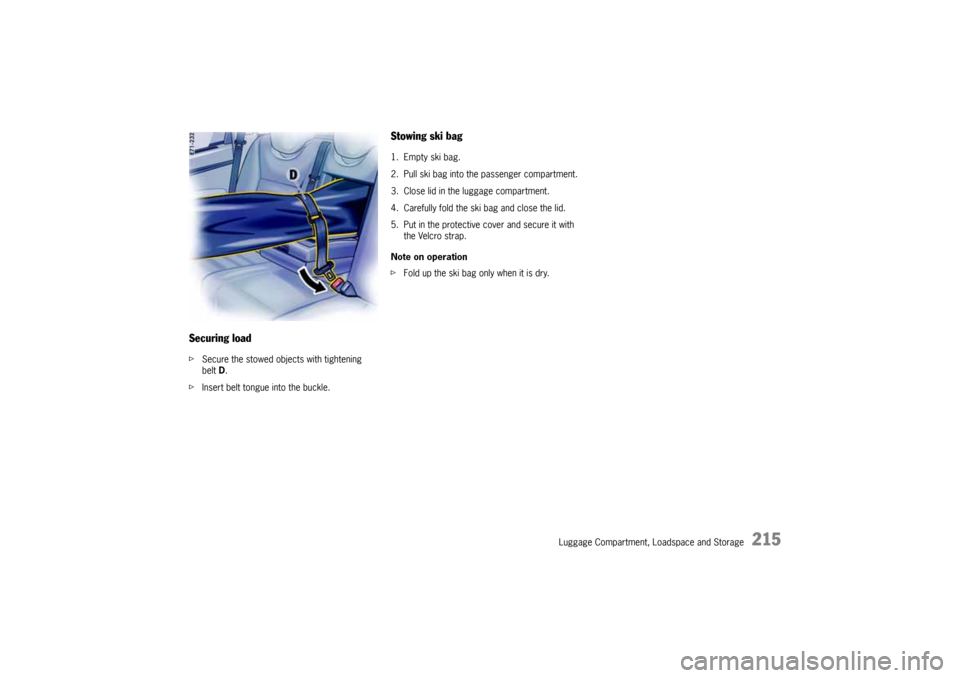
Luggage Compartment, Loadspace and Storage
215
Securing loadfSecure the stowed objects with tightening
beltD.
fInsert belt tongue into the buckle.
Stowing ski bag1. Empty ski bag.
2. Pull ski bag into the passenger compartment.
3. Close lid in the luggage compartment.
4. Carefully fold the ski bag and close the lid.
5. Put in the protective cover and secure it with
the Velcro strap.
Note on operation
fFold up the ski bag only when it is dry.
10_Cayenne_21_KW17.book Seite 215 Donnerstag, 9. April 2009 3:33 15
Page 216 of 379

216
Luggage Compartment, Loadspace and Storage
Roof Transport SystemfPlease follow the separate instructions for
fitting the Roof Transport System.
fPlease see the chapter “LOADING
INFORMATION” on Page 231.
Fitting normal commercially available luggage
racks is not possible.
The Porsche Roof Transport System allows the
transport of various sports and hobby equipment.
Your authorized Porsche dealer will be pleased to
tell you about the varied uses of the Roof
Transport System.
Safety Notes!
Risk of an accident, loss of control and
damage to the vehicle.
fCompletely remove the Roof Transport System
before using an automatic car wash – risk of
damage to the vehicle.
fDo not exceed the permissible roof load, the
permissible gross weight and the permissible
axle loads.
Please see the chapter “WEIGHTS” on
Page 356.
fDistribute load evenly, with heavy items as low
as possible. Items of luggage must not project
beyond the side of the load area.
fFix and secure every item to the basic carrier
with a rope or lashing strap (do not use elastic
rubber tensioners).
fBefore every trip, and at regular intervals
during long trips, check that Roof Transport
System and load are secure. Re-tighten if
necessary and secure additionally by locking.When the Roof Transport System is loaded, the
maximum speed depends on the nature, size and
weight of the load being carried.
fAdapt your driving style and speed to the
changed conditions.
Nevertheless, Porsche recommends that you
do not exceed the posted speed limit.
Driving, braking and steerin g b e h a v i o r c h a n g e d u e
to the higher center of gravity and the greater
wind-resistant area. You should adapt your driving
style appropriately.
fSince fuel consumption and noise are in-
creased with the Roof Transport System fitted,
it should not remain on the car if not in use.
10_Cayenne_21_KW17.book Seite 216 Donnerstag, 9. April 2009 3:33 15
Page 217 of 379
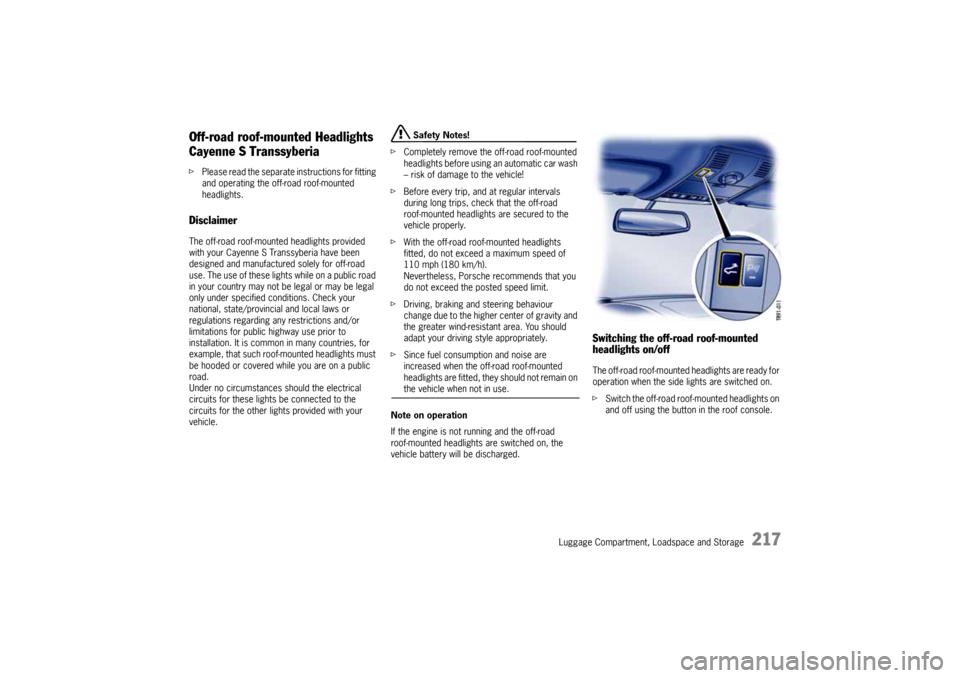
Luggage Compartment, Loadspace and Storage
217
Off-road roof-mounted Headlights
Cayenne S TranssyberiafPlease read the separate instructions for fitting
and operating the off-road roof-mounted
headlights.DisclaimerThe off-road roof-mounted headlights provided
with your Cayenne S Transsyberia have been
designed and manufactured solely for off-road
use. The use of these lights while on a public road
in your country may not be legal or may be legal
only under specified conditions. Check your
national, state/provincial and local laws or
regulations regarding any restrictions and/or
limitations for public highway use prior to
installation. It is common in many countries, for
example, that such roof-mounted headlights must
be hooded or covered while you are on a public
road.
Under no circumstances should the electrical
circuits for these lights be connected to the
circuits for the other lights provided with your
vehicle.
Safety Notes!
fCompletely remove the off-road roof-mounted
headlights before using an automatic car wash
– risk of damage to the vehicle!
fBefore every trip, and at regular intervals
during long trips, check that the off-road
roof-mounted headlights are secured to the
vehicle properly.
fWith the off-road roof-mounted headlights
fitted, do not exceed a maximum speed of
110 mph (180 km/h).
Nevertheless, Porsche recommends that you
do not exceed the posted speed limit.
fDriving, braking and steering behaviour
change due to the higher center of gravity and
the greater wind-resistant area. You should
adapt your driving style appropriately.
fSince fuel consumption and noise are
increased when the off-road roof-mounted
headlights are fitted, they should not remain on the vehicle when not in use.
Note on operation
If the engine is not running and the off-road
roof-mounted headlights are switched on, the
vehicle battery will be discharged.
Switching the off-road roof-mounted
headlights on/offThe off-road roof-mounted headlights are ready for
operation when the side lights are switched on.
fSwitch the off-road roof-mounted headlights on
and off using the button in the roof console.
10_Cayenne_21_KW17.book Seite 217 Donnerstag, 9. April 2009 3:33 15
Page 218 of 379

218
Luggage Compartment, Loadspace and Storage
Car Audio Operation/TipsFor radio operation see your radio manual
which is included with your on-board litera-
ture.FM receptionA vehicle is not an ideal place to listen to a radio.
Because the vehicle moves, reception conditions
are constantly changing.
Buildings, terrain, signal distance and noise from
other vehicles are all working against good recep-
tion.
Some conditions affecting FM may appear to be
problems when they are not.
The following characteristics are completely
normal for a given reception area, and they do not
indicate any problem with the radio itself.
Note
Electronic accessories should only be installed by
your authorized Porsche dealer.
Equipment which has not been tested and
approved by Porsche may impair radio reception.Fading and drifting
FM range is limited to about 25 miles (40 km),
except for some high power stations.
If a vehicle is moving away from the desired
station's transmitter, the signal will tend to fade
and/or drift. This condition is more prevalent with
FM than AM, and is often accompanied by
distortion.
Fading and drifting can be minimized to a certain
degree by careful attention to fine tuning or selec-
tion of a stronger signal.
Static and fluttering
When the line-of-sight link between a transmitter
and vehicle is blocked by large buildings or moun-
tains, the radio sound may be accompanied with
static or fluttering because of the characteristic of
FM.
In a similar effect, a fluttering noise is sometimes
heard when driving along a tree-lined road.
This static and fluttering can be reduced by
adjusting the tone control for greater bass
response until the disturbance has passed.Multipath
Because of the reflecting characteristics of FM, di-
rect and reflected signals may reach the antenna
at the same time (multipath) and cancel each other
out.
As a vehicle moves through these electronic dead
spots, the listener may hear a momentary flutter
or loss of reception.
Station swapping
When two FM stations are close to each other, and
an electronic dead spot, such as static or multi-
path area, interrupts the original signal, some-
times the stronger second signal will be selected
automatically until the original one returns.
This swapping can also occur as you drive away
from the selected station and approach another
station of a stronger signal.10_Cayenne_21_KW17.book Seite 218 Donnerstag, 9. April 2009 3:33 15
Page 219 of 379
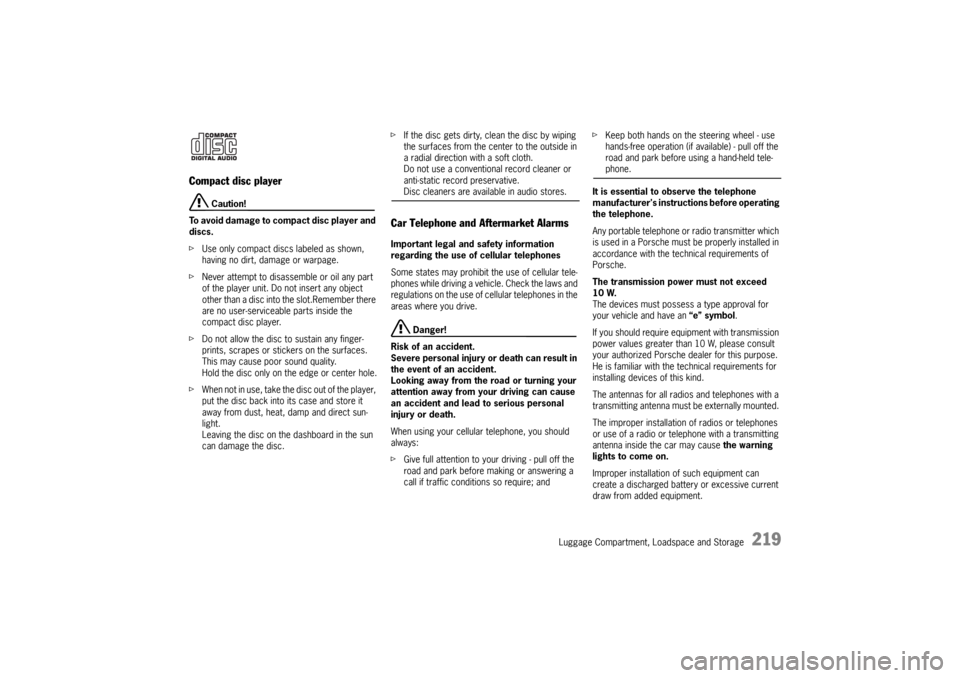
Luggage Compartment, Loadspace and Storage
219
Compact disc player
Caution!
To avoid damage to compact disc player and
discs.
fUse only compact discs labeled as shown,
having no dirt, damage or warpage.
fNever attempt to disassemble or oil any part
of the player unit. Do not insert any object
other than a disc into the slot.Remember there
are no user-serviceable parts inside the
compact disc player.
fDo not allow the disc to sustain any finger-
prints, scrapes or stickers on the surfaces.
This may cause poor sound quality.
Hold the disc only on the edge or center hole.
fWhen not in use, take the disc out of the player,
put the disc back into its case and store it
away from dust, heat, damp and direct sun-
light.
Leaving the disc on the dashboard in the sun
can damage the disc.fIf the disc gets dirty, clean the disc by wiping
the surfaces from the center to the outside in
a radial direction with a soft cloth.
Do not use a conventional record cleaner or
anti-static record preservative.
Disc cleaners are available in audio stores.
Car Telephone and Aftermarket Alarms Important legal and safety information
regarding the use of cellular telephones
Some states may prohibit the use of cellular tele-
phones while driving a vehicle. Check the laws and
regulations on the use of cellular telephones in the
areas where you drive.
Danger!
Risk of an accident.
Severe personal injury or death can result in
the event of an accident.
Looking away from the road or turning your
attention away from your driving can cause
an accident and lead to serious personal
injury or death.
When using your cellular telephone, you should
always:
fGive full attention to your driving - pull off the
road and park before making or answering a
call if traffic conditions so require; andfKeep both hands on the steering wheel - use
hands-free operation (if available) - pull off the
road and park before using a hand-held tele-
phone.
It is essential to observe the telephone
manufacturer's instructions before operating
the telephone.
Any portable telephone or radio transmitter which
is used in a Porsche must be properly installed in
accordance with the technical requirements of
Porsche.
The transmission power must not exceed
10 W.
The devices must possess a type approval for
your vehicle and have an “e” symbol.
If you should require equipment with transmission
power values greater than 10 W, please consult
your authorized Porsche dealer for this purpose.
He is familiar with the technical requirements for
installing devices of this kind.
The antennas for all radios and telephones with a
transmitting antenna must be externally mounted.
The improper installation of radios or telephones
or use of a radio or telephone with a transmitting
antenna inside the car may cause the warning
lights to come on.
Improper installation of such equipment can
create a discharged battery or excessive current
draw from added equipment.
10_Cayenne_21_KW17.book Seite 219 Donnerstag, 9. April 2009 3:33 15
Page 220 of 379

220
Luggage Compartment, Loadspace and Storage If aftermarket systems are installed by non-dealer-
ship technicians or outside the selling dealer,
problems may result. Installation of aftermarket
equipment is not covered under the New Car
Warranty.
fConsult your authorized Porsche dealer about
the installation of non Porsche approved equip-
ment.
Reception quality
The reception quality of your car telephone will
change constantly when you are driving. Interfe-
rence caused by buildings, landscape and wea-
ther is unavoidable. It may become particularly
difficult to hear when using the hands-free function
due to external noise such as engine and wind
noise.
Automatic car-wash
fUnscrew external antennas before using an au-
tomatic car-wash.
Porsche Communication
Management (PCM)
Warning!
There is danger of accident if you set or
operate the on-board computer, radio, navi-
gation system, telephone or other equipment
when driving.
This could distract you from traffic and
cause you to lose control of the vehicle re-
sulting in serious personal injury or death.
fOperate the components while driving only if
the traffic situation allows you to do so safely.
fCarry out any complicated operating or setting
procedures only with the vehicle stationary.
fIf it is necessary to operate these components
while the vehicle is in motion, use the function keys on the multi-functional steering wheel.
fRefer to the separate operating instructions
before putting the PCM into operation.
When put into operation for the first time, a
distance of approx. 3 miles (5 km) must be driven
in order for the navigation system to complete the
process of fine calibration. The same applies
when the tires are changed (e.g. summer/winter
tires) or new tires fitted. Full location accuracy is
not yet achieved during the fine-calibration
process.If the vehicle has been transported (e.g. ferry, car
train), the system may take a few minutes after
being switched on before it determines the current
location.
Serious tire slip (e.g. spinning wheels on snow)
may result in temporarily inaccurate navigation.
When the battery has been disconnected, it may
take up to 15 minutes before the navigation
system is operational once more.
Satellite radioYou must have the satellite radio activated before
you can put it into operation. You will need a
contract with a provider in order to use this radio.
fRefer to the separate radio operating instruc-
tions before putting into operation.
10_Cayenne_21_KW17.book Seite 220 Donnerstag, 9. April 2009 3:33 15